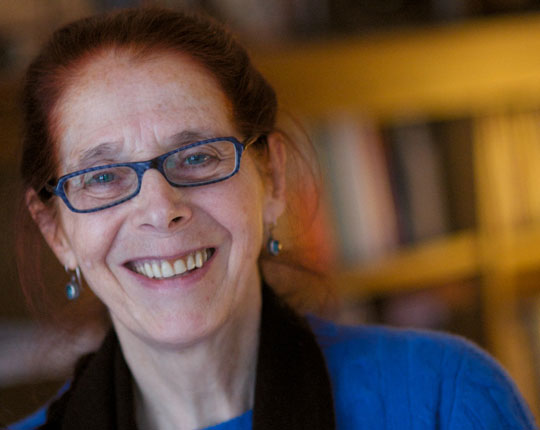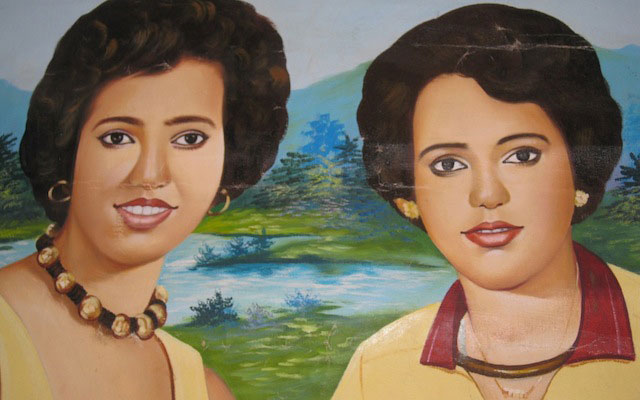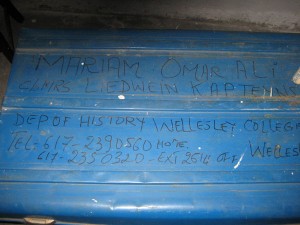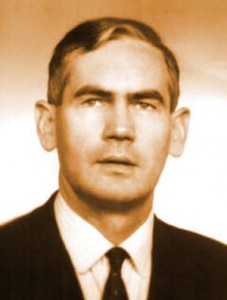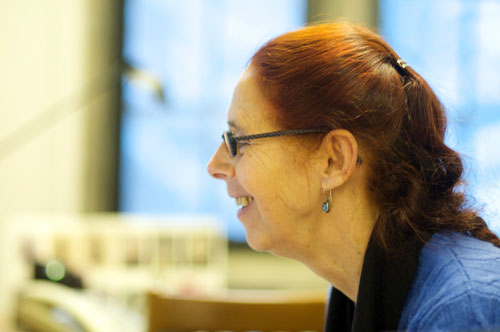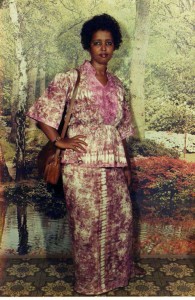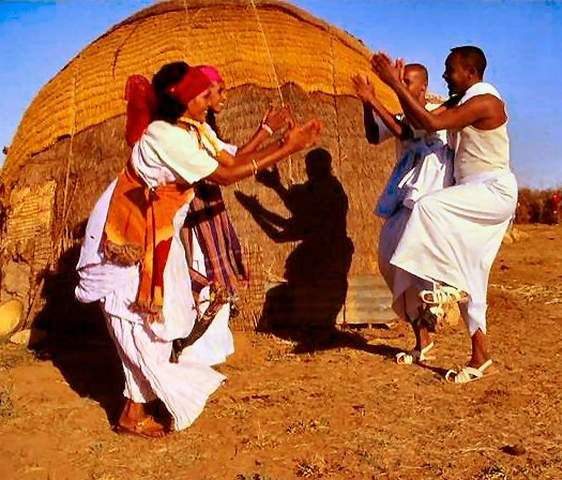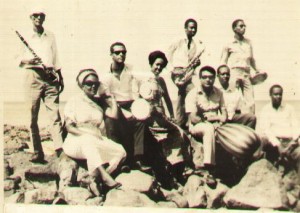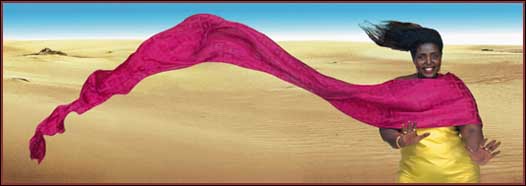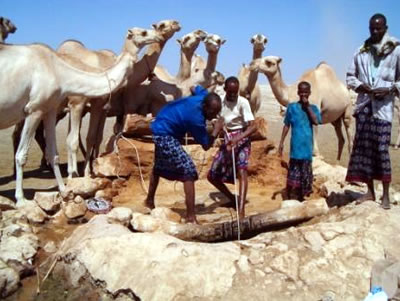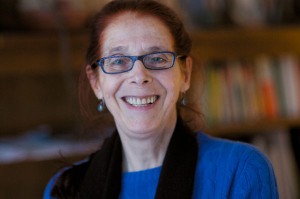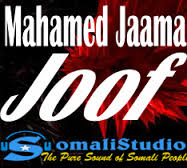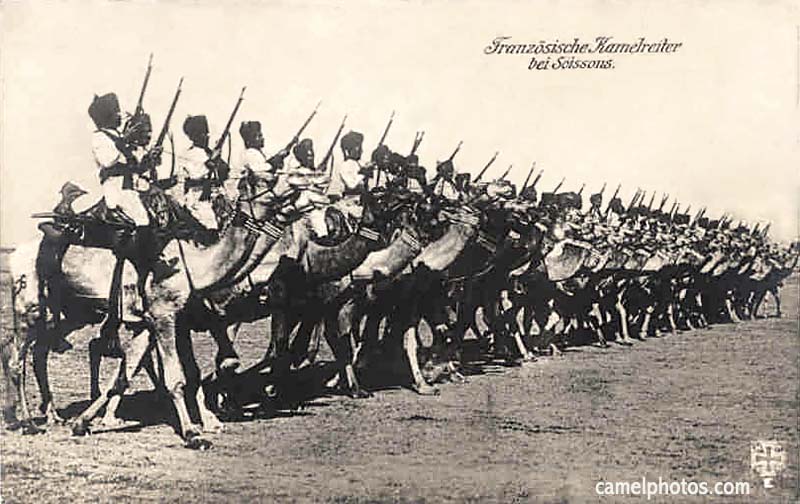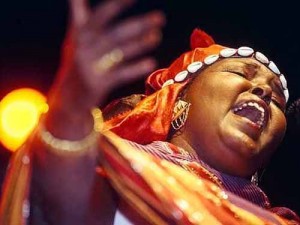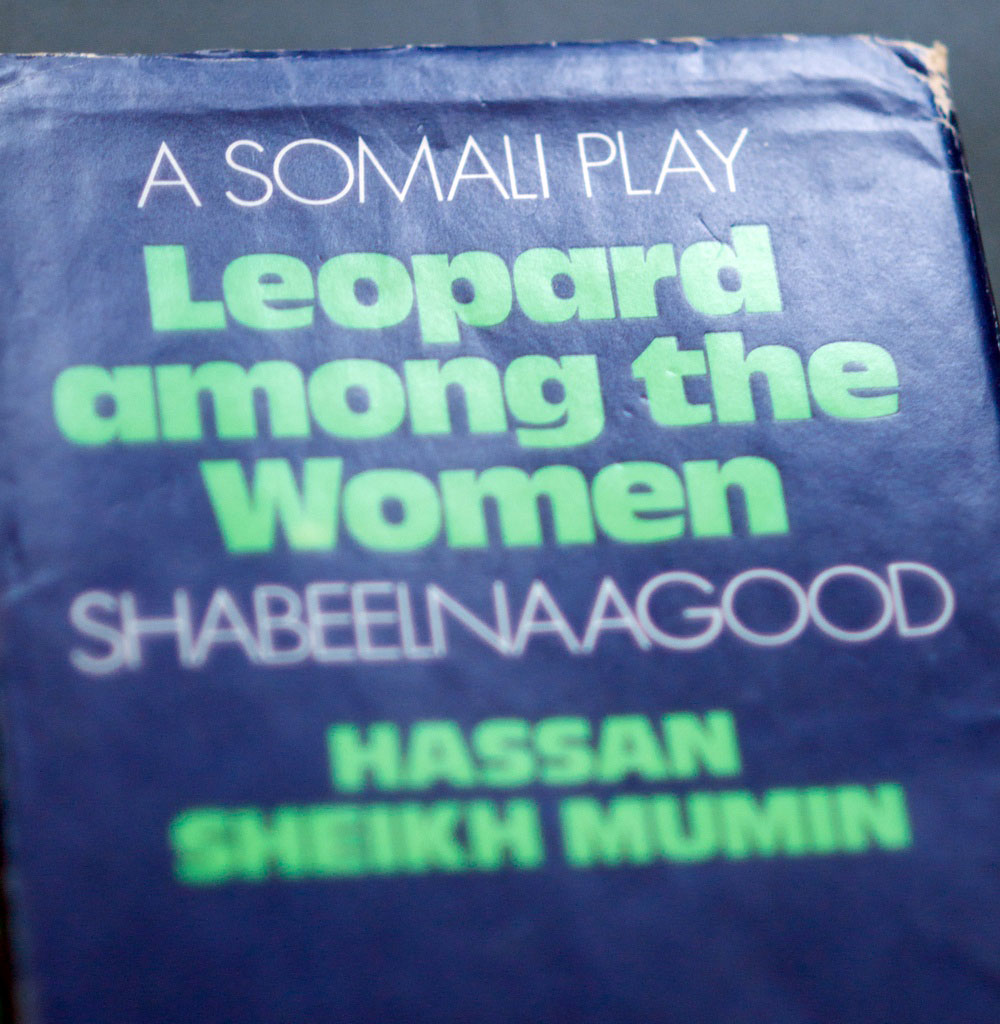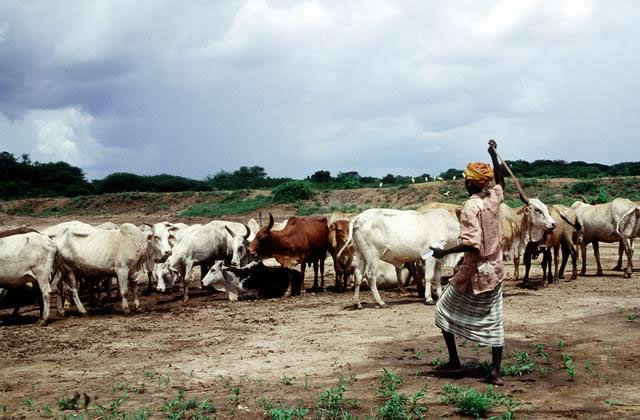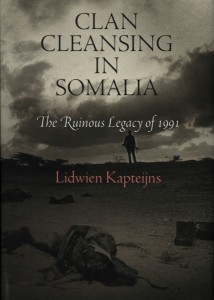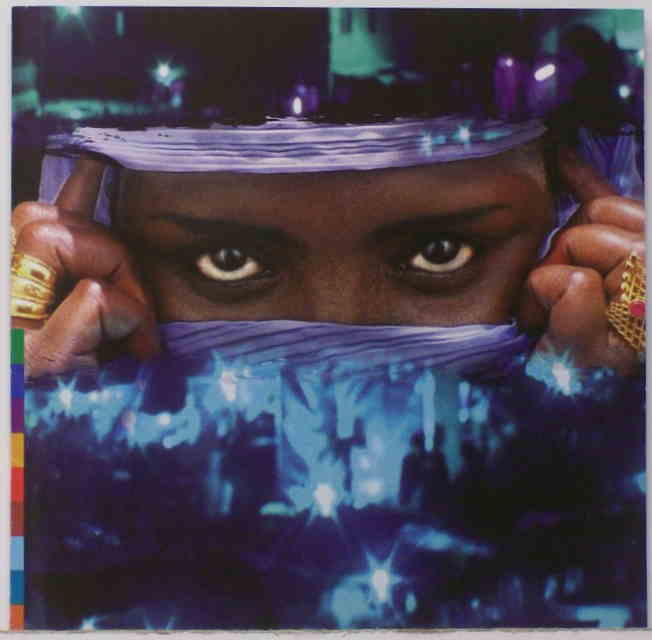Lidwien Kapteijns is a professor of history at Wellesley College. A few years ago, she contacted Afropop Worldwide to say she was a co-trustee of a large collection of rarely heard songs from Somalia. These songs date from between about 1955, when the country was approaching independence, and 1990, when it was disintegrating into a devastating period of civil conflict. Professor Kapteijns said that the love songs in particular in this collection reveal a now-hidden chapter in Somali history, a time when the country was actively searching for a way to balance old tradition and culture with the coming wave of modernity. Kapteijns provides the principle voice in the resulting Afropop program, Reconstructing Somalia: Love Songs at the Birth of A Nation. Afropop’s Banning Eyre braved a February snowstorm to visit Kapteijns in her office at Wellesley. Here’s their conversation.
Banning Eyre: Welcome. Let's start at the beginning. Introduce yourself and tell us how you got involved with Somali music. But before we do that, how do we correctly pronounce your name?
Lidwien Kapteijns: The Somalis call me Prof. Ladan. Actually, it's a beautiful name. Ladan has the connotation of health and wealth. We’re not talking about Michael Jackson wealth, of course. But in English, I’m Lidwien Kapteijns [LID-win CAP-tains] with my forefather being the captain of the archer's guild of our village in Holland.
So your name is related to the English word "captain."
It is. It's the same word. As for me and Somali music, it's a long story. I was a student at the University of Amsterdam in Holland, and I got really interested in Africa, and I realized that, in Holland, you couldn't do African history. This then brought me to London to the School of Oriental and African Studies (SOAS), where I did an M.A. called the Area Study of Africa. At that time you were not allowed to do Arabic, which was the language I was studying, as part of an M.A. on Africa. So it was actually a second choice for me to do Somali. There was a Cushitic reader whom most Somalis know as Professor Goosh—[Bogumil Witalis] “Goosh” Andrzejewski. He taught Somali and he accepted me into the program. So that's how I got really interested in the Somali language.
When was that?
That was ’74, ’75. And of course, Somalia was under Soviet rule. So when I finished my M.A., I couldn't go to Somalia, because it was very hard as a Westerner to get into Somalia. And I had done Arabic, and I had a roommate from Sudan, so I actually went to Sudan. I spent five years in Sudan teaching high school and university and working on what later became my dissertation. But I really loved the Somali language, and it didn't quite let me go. And so when I came to the U.S. and started teaching here at Wellesley, I said, "I am not done with that language. Let me see what I can do."
At that moment, there were very few Somalis in the U.S. Now, it is much easier to learn Somali, because there are Somalis everywhere. And so I asked two colleagues, one in Djibouti and one in France, for a pen pal. Very old-fashioned, right? A pen pal. And they introduced me to Maryan Omar Ali. Maryan Omar Ali is the person who actually made it her life's work to collect Somalis songs, and she taught me. By the way, may God rest her soul, because she died a couple of years ago. Maryan always said, "If God had given me a voice, I would've been a singer, but since He didn't, I am the one who will document and collect the songs."
And so Maryan and I became pen pals. I met her in Djibouti the first time. In the years that followed, we spent many summers together, many, many weeks together. And she was always making fun of me because I was a very gung ho, active, make-use-of-your-time person, and she would come to me and say, "Ladan,"-- that's my Somali name. "Come and sit with me." And I would say, "Maryan, I have no time. I have to do this or that."
"Let's listen to the songs."
"But I don't understand them."
"I will explain to you."
And the rest is kind of history. So it is in working with Maryan that I got really interested in the songs. And I think that Maryan’s own interest in transcribing the songs and documenting them, rather than just collecting them, also grew. She could recognize all the voices, which I cannot do yet, even today. Some, I can. And so it became like a really wonderful collaboration. Eventually, this became part of the book Women's Voices in A Man's World, in 1991, which I wrote with Maryan Omar Ali, because Maryan helped me with the song texts. That was not our plan. We really started doing it because we loved it, and I think I learned a lot of the language, the Somali language that I know, from the pop songs.
So when you were sitting and listening to these songs with Maryan, you were dealing with her large collection of recordings, a collection that you now co-curate with Professor Ahmed Samatar. Tell us the story of this collection.
Yes, well, I have got to create one image for you. Because when I first knew Maryan, she had one of these big iron trunks that people who travel to Africa used to use. She had a big blue iron trunk in which she brought all the cassette tapes to North America from Djibouti. And we used to call it the Love Boat, because it was full of love songs. In our friendship, I should say because we were not necessarily thinking yet of making this into scholarly work also, we then bought early on a piece of equipment so that Maryan could digitize this and put it on CDs and all that. And so in the end, I think Maryan has over 2,000 songs, and we transcribed a number of them. We translated some of them, although they are mostly just handwritten still. And Maryan digitized a large number of them.
As for the physical collection of cassette tapes right now, Ahmed Samatar, a professor of International Studies at Macalester College, and I are co-trustees, trying to try to find a home for it. Of course, the physical collection is harder and harder to make somebody happy with. Because a physical collection of cassette tapes is bulky and not very accessible as a source.
Maryan Omar Ali's trunk full of love songs!
How much is digitized?
I'm not exactly sure, but quite a bit. Quite a bit.
And of the ones that are digitized, a number of them can be heard online, on the HiddoSongs channel you’ve created on YouTube, right? Others may be on other sites. How much of it is publicly available this way?
You know, I think it's a lot. It's kind of surprising—with the whole country going up in violence since the early ’90s—how much Somali music has been saved. So I think that, looking at Maryan’s collection, practically every song would be circulated some place. But the goal of the HiddoSongs channel is to have it as a collection, in memory of Maryan, with the name of the singers. We don't have enough names of the poets, and that is now also coming out on the Somali Internet. A colleague who studied this, probably about 10 years ago, said that there were then over 700 Somali websites. Now they are not all equally significant. Some may no longer be there. But they all have a music section. So it is not that Somali music is unavailable. But we are still working to keep it together as a collection, and make it searchable, by artists and song titles.
We also have the plays, the theatrical plays, in which most of these songs first came out in Mogadishu. We don't have enough of the composers of the texts and the melodies. So that is research to be done.
So there's still a lot of work to do in documenting the collection.
I think several PhD's.
And the physical collection of cassettes in the love trunk, where is that physically?
Physically, here with me in Wellesley. Ahmed and I are talking to see where we might find a place for it.
I'm familiar with the problem. We have a lot of issues with our own archive. It is difficult to deal with all these old forms of media—very problematic, and hard work.
If it is what you love, and what you think is so important, then you try to stay with it. I will not mention the name, but there was a music archive to which Maryan and I offered the cassettes at one point. I was asking for something for the cassettes and some money for Maryan’s labor. They were only willing to pay for the cassettes, and so we said, "Well, no. Thank you very much."
But, listen. Shall I tell you the first pop song that caught me? This is before Maryan came into my life. I was working under Professor Andrzejewski at SOAS, and I invited him to come from London to speak at the University of Amsterdam. So he was staying with me, and I had this old radio, you know the old radio with the cloth front, probably inherited from a grandmother. And he said, "Hey, it's time for the British Somali service." I didn’t have a shortwave, but he said, “Well, let's try this one.” So both of us in this small apartment, lying on our bellies on the floor. And Goosh [Andrzejewski] was a prestigious professor. We were trying to find the Somali World Service, and we found it. And what was on? The beautiful song by Hasan Aden Samatar called "Aaminaay Xusuusnow (Remember Amina).”
Bogumil Witalis “Goosh” Andrzejewski
And it's a song that says, "Amina, remember. If you let the words go out of your mouth, and they go out among the people, then you don't control them anymore." And the whole song is then, "We have a date. Don't forget. Wednesday night at 10 p.m. Let's get together." It's really a lovely Mogadishu love song. I think it always stayed with me.
And you know, I was in Mogadishu once in 1987 when the political situation had really deteriorated, and there was not much history I could do, but I remember the songs were everywhere. And for example, another beautiful song sung by Hasan Aden Samatar, this one in Af Maay—that's the language/dialect of the riverine region in the south of Somalia. The song was "Diinleeya," about a girl the singer wants to get but has trouble getting. It was everywhere. So when people say they were no Af Maay songs, I say, "Listen, I was in Mogadishu one summer, and that song was everywhere and everybody was singing it." So anyway, my interest was in some sense already there before I met Maryam, but then it became more serious.
Let's back up and give our listeners a little bit of a history lesson here. Let's just set the scene for the story we’re going to tell. The history of Somalia is complicated, and not well known. To me, things that are particularly interesting are the fact that this is such a large area where people speak more or less one language. To have such a large area with one ethnicity is quite different from a lot of the African stories we have told on our program. By contrast, if you look at Congo or Tanzania, these have hundreds of ethnic groups. But start where you like. Give us a thumbnail sketch of Somali history.
Well, let’s talk about the Somali history that is relevant to our topic, which is the popular songs of the nationalist era, from about 1955 until the 1991 stage of the Civil War —or the 1988 stage, when the northwest was totally destroyed. The history most relevant to that is the history of colonial occupation. Unfortunately, the Somali-inhabited territories were divided up into five parts. First, there is Italian Somaliland, with Mogadishu as capital. Then, there is what is now the Republic of Somaliland—self-proclaimed—at the time, British Somaliland. Those two came together in 1960 at independence. Then there is French Somaliland, which is now the Republic of Djibouti. Ethiopia still has a large part of Somali-inhabited territory called by some—everything is political in the Somali context—Western Somalia, or Ogadenia. This is a very rich, beautiful area that borders on what is now the Republic of Somalia. And finally, you have a large area of Kenya that was called the Northern Frontier District. By the way, neither the Ethiopian area, nor what is now in Kenya, is exclusively inhabited by Somalis. There are also Oromo and other groups. But they were then predominantly Somali.
And so, there are five different areas. And the Somali flag, the national flag, the blue flag with a white star, has five points. And each point, points to one of these areas, which the Somali Republic, when it united in 1960, wanted to liberate and bring into the fold of the nation state.
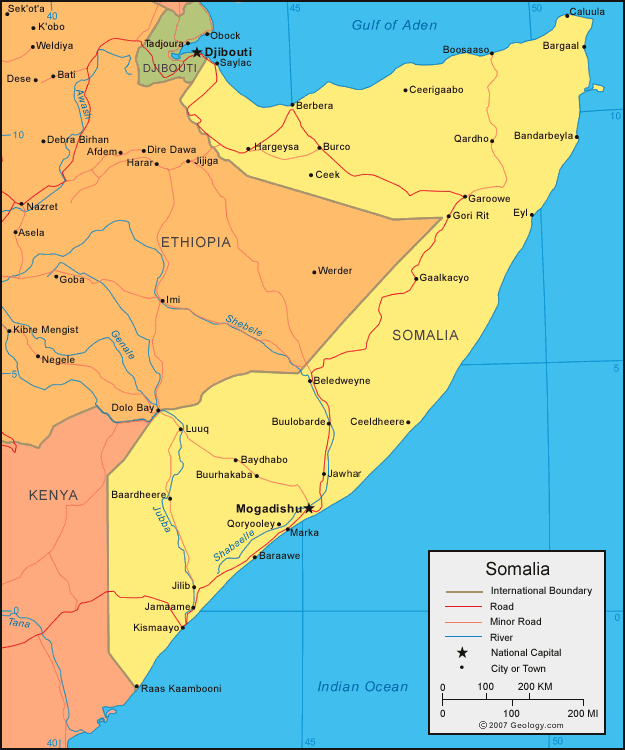 Fascinating. But what about before the colonial forces came, how unified was this big Somali inhabited territory?
Fascinating. But what about before the colonial forces came, how unified was this big Somali inhabited territory?
Yes. So, you're going to ask: What was there before? There is kind of a myth, and actually I think I've argued it myself once in the distant past, that Somalis didn't have states. Somalia did have states. They were small states. Some of them were city-states. Mogadishu would be an example. Brava. Merca. They were small city-states on the coast. There was Zeila in the Northwest. And they also had inland states. Many people have heard of Harar in Ethiopia. It is also a walled city-state. They were other city-states, whether you go from Berbera toward Ethiopia, or you go from Mogadishu towards Ethiopia, there were small city-states that rose and fell in the course of history.
And that meant that the people who lived there, although they shared an ethnic background, also had city identities. I have met, for example in Djibouti, people from Zeila who say, "Well, you know, we didn't used to be a Somali." And in that case, the `Isa [Esa] and Samaron groups are dominant. "We did not used to be `Isa or Samaroon. We used to be Zeila`i, people of Zeila. And our ethnic backgrounds were very secondary." So that's one thing. There were also other forms of state formation—political alliances with central leadership, such as the Ajuraan Sultanate.
Of course, very large numbers of Somalis, like many other societies in the period before 1880, were living in non-state societies. All were agrarian, but not all had farming as their mode of livelihoods. And so we have this in Somalia in the inter-riverine area up to Kismayo. In these places, we have mixed agriculture that includes cattle-keeping, cow husbandry, camel husbandry—and this is brought out in the pop songs. Practically all Somali regions also had camels. And so, in hindsight, what came out is that the people who had cows and farms felt a little bit excluded from all the nationalist imagery that only spoke about camels—the proud Somali camel and camel herd. Yet, even the people who were complaining that their cows were not represented, themselves had many camels.
So at some point, everything becomes a little bit contested. But it's an agrarian society, nomadic camel husbandry, mixed agriculture, cows in the south-central part. And Somali nomads and farmers often organized themselves as stateless societies, of which people might want to think as tribal societies, or clans, societies without single rulers or kings.
Lidwien Kapteijns (Eyre 2014)
And is it really true that all these people share a single language?
Well, this is almost true. There is a large area in south-central Somalia that has a different dialect. But is it a different dialect, or is it a different language? I try to be so fair. I have asked linguists, and they say, "Listen, they are right on the boundary of a different dialect or a different language." The Af Maay speakers like to kind of ambush you, or ambush a Somali, by saying something in Af Maay. And if you can't follow it, they say, "You see? We have a different language." But Somalis who've lived in Af Maay-speaking territories say that it takes just a couple of weeks and then they can follow it. So it's right on that border of being totally mutually intelligible, but not quite. So I'm OK with considering Af Maay a separate language if its speakers want that. But the fact is that those two languages, or those two dialects, are very closely related.
One of the songs I prepared for you, the Dinleeya song, is in the Af Maay dialect. So I do think it is another wonderful source of historical information and richness, that there is actually great diversity within Somali language and culture.
So you've painted a picture of these loosely connected non-state, tribal societies and city-states, politics of some sort, and for the most part, they do share a language, so there is a certain unity...
Though maybe no political unity.
No political unity. But a cultural unity. And that's what I want to ask about. I want you to introduce the idea of the very strong Somali poetic tradition, and how that can be so powerful over such a large area of geography that mostly shares language--again, something you don't find that much in Africa. It seems to me that that unity must feed this poetic tradition. But I'll let you comment.
The popular cultural legacy of the Somalis in this precolonial period put an emphasis on song and poetry. Now we have to realize that we look back at that poetry through the prism of the colonial period. In British Somaliland, the British wanted the Somali as tribal as possible. To them, these city Somalis were just dandies who had lost their cultural ways and all that. But nevertheless, if you look at what has been preserved in terms of oral poetry and oral song, then we have a staggering amount of poetry and song genres--you have the shirib in the south and the dhaanto in the west, which you can find on the Internet, all kinds of genres of folk song and dance. I write a little bit about these in the first part of Women's Voices. But I really don't talk much about the genres. I talk about the texts. In any case, the oral poetry typical of these non-state agrarian communities make up a significant part of the Somali cultural heritage.
And then, you have what at some point in Somali history became the so-called "prestigious
Maryan Omar Ali (Lidwien Kapteijns photo)
poetic genres." And I say so-called, because, of course, we have done a feminist critique of that by now, right? But the prestigious Somali genres, about which Said Samatar wrote in his book called Oral Poetry and Nationalism, about the movement of Mohamed 'Abdallah Hasan, who led his jihad against the colonialists from 1898 to 1921. Said Samatar has the most beautiful analysis of this poetry, this prestigious male poetry. And that poetry was for and by serious men about serious issues. And serious issues means politics and philosophy.
So the folk dances and the folk genres may indeed also deal with and raise all kinds of issues—everything is political in the end. But the prestigious poetry (such as gabay and geeraar) that was the genre that came to be seen as the place you discussed important matters and communicated with important people in society, and tried to persuade the rest of the people. And they were very powerful. They could play a role in making war and peace. Andrzejewski has argued that one of the reasons that the Somali language is so rich is because these poets wanted to show off their linguistic virtuosity. They actually created new words, and if you sit with Somalis and try to translate some of that poetry, people will say, "Ah, it makes me think of something. But it's a new word." And so this poetry is rich in all the ways Said Samatar so beautifully describes. And our pop songs, the pop songs that we are talking about, draw on those “prestigious” poems.
So do people in Somalia all share this poetic tradition?
Well, Somalis may have had cultural commonalities, but they have never been a nation-state. Let's look at the ’50s. There is a very, very active nationalist movement among Somalis, in all the five territories. And in 1960, of course Somalia gets independence. And the two British and Italian Somalilands come together. Now this generation of Somalis have to build a state, but at some level, they also have to create a nation out of these different groups of Somalis who have a lot in common. They have many things in common, they have some customs in common, they have language, languages in common, they are very fired up against colonialism. There is certainly a sense of wanting to be autonomous and independent.
So the way that the popular song develops is really interesting. It begins with people who bridge the traditional sector—or the rural sector, let's say—and the new cities. They are truck drivers. They might be primary school teachers. They might be people that come from the more urbanized Aden colony, the center of the British colony of Aden, in what is now in Yemen. And so they began to make music, some of it just for their entertainment.
And two things happen that the ulama—the religious authorities—find scandalous. They sit down to make music. It's not a courtship dance, not a folkloric dance. And they sit down in mixed company. Somalis did have mixed entertainment events in the past, courtship dances and that sort of thing. But this was new—sitting down in mixed company to make music, at night—and so it was looked down upon.
Now the genre that emerges there is often called belwo. Belwo means almost like lament of the heart. The original belwo songs are maybe like a blues almost, because it is a lament. It's really about a modulation of the voice. So you really need a very good singing voice to do that. We have now put on this genre the wider label of qaraami. A qaraami is a collection of several belwos. There are people who are totally expert in this, but I don't think they would disagree that qaraami songs are laments of love, with minimal musical accompaniment. They only have the lute and probably some drum-like instrument; and perhaps a flute. People sometimes used to just use pots and pans. It is a two-line, alliterating text, sometimes with a third line as a refrain.
I have read some of those very short, two-line poems. But when they are performed, are they really that short? Or do they repeat lines?
 L. Kapteijns goes beyond the call of duty for Hip Deep! (Eyre)
L. Kapteijns goes beyond the call of duty for Hip Deep! (Eyre)
They are totally not short. You are right. They are short in text. But in a qaraami song, there might two women, or woman and a man, they will sing the two lines with the refrain, and then another person will sing the two other lines. So they repeat everything twice, and they will have a whole repertoire of these.
Why don't you introduce one of these?
OK, this is a good example. It says, "Dear God, I never failed to receive good things from you. After all my problems, bring me something good." The lines that I quoted in Women's Voices are, "What the merciful God decrees for you, no one can take away. You cannot be dissatisfied with the share God gives you." But it means of course: I am in a terrible condition. My love is not being returned. Or maybe you are just unemployed and in a difficult position. Another one will be, "If you were a flower with a strong scent, you would be very fragrant." Well, of course, we can't say Somalis never fell in love in the precolonial period. And we have actually some beautiful poetry, one about a man whose wife dies. But to sing about desire, about physical desire, was totally new. And it was part of why this first stage of the pop song was frowned upon. Sitting down. At night. Mixed company. Singing of love. Oh, my God!
I’d like to say one more thing about the belwo and how frowned upon it was. The parents of the first singers were being denied access to a mosque in their hometowns, just because their children were singing these belwos. This is how much people disapproved.
And this is happening in the 1950s.
1950s and early 1960s. Absolutely. And it's a genre that keeps going and still exists.
And you say one qaraami is actually a combination of many belwo, those short couplets, right?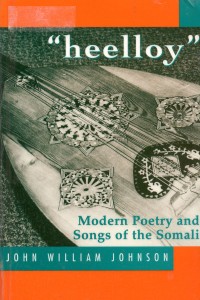
Yes. The pop song has many influences. But as text, it is a stringing together of two-liners that then become four, six, eight, 12-liners. And always each line is repeated, or the two lines of each couplet are repeated. And they follow the alliteration, meaning that every line needs to have two words that alliterate on the same consonant. And if it is a vowel, it is considered a vowel and does not have to be an "a" or an "o" only. You need two words with a vowel, one in each half of the line. So alliteration is one of the restrictions of form, or the characteristics of form of the Somali pop song, and Somali poetry for that matter.
The expert on this, really, is John Johnson. There are Somali experts, of course, but the one most accessible in English, about the meter and melody and rhythm, the formal characteristics, is John Johnson. I think he is now an emeritus at Indiana University in Bloomington. So he actually has, together with Somali colleagues, worked out the formal characteristics. It's not just alliteration but also meter, the number of long vowels and short vowels, the length of the line, the melody, etc.
My own story is perhaps interesting here because I could not follow what these people were writing about. Short vowels and long vowels? And I remember my first visit to Djibouti, a friend of Maryan’s was talking to me, and he began to talk about the work songs, and he sang them for me, and I began to learn some of the forms and genres just by memorizing. I couldn't tell you the number of long and short vowels, but I think the organic poets learned this on their mother’s back, next to the fire, working with father. But anyway, it is quite complex. John Johnson can give you extensive information on that. People should look at his work. It is available.
In the program, you give a couple of examples of this poetic alliteration. And we can hear it. Does this tradition survive in the popular songs we’re talking about?
Absolutely. This happens in the pop song too. But they don't have to keep the alliteration going for the whole song. They can do two lines, two lines, two lines.
We should also mention other musical influences on the pop song. There are Indian
John Johnson
influences. There are Arab influences. You know, Somali musicians and poets in this late colonial and early independence periods were totally wide open to the world. We have radio influences also, of course. We get Radio Hargeisa; Radio Mogadishu is open just before that. So radio is a force in making this group of people into a nation. And certainly there are influences, direct influences from the colonial entertainment forms.
So this is the 1950s. Tell us all the different kinds of music that people would be hearing on the radio stations at that point.
On the radio stations, I'm not exactly sure how much outside music they would hear. There would be a lot of Somali music played. But certainly there would also be Arab music played. But I think that if you are in Aden, for example—some of the earlier musicians had connections to Aden, or even went to school in Aden —then you are open to the whole Indian Ocean world. The same for Mogadishu and its connection to Zanzibar and beyond. In the '60s, poets also traveled. To Sudan, Ethiopia, Kenya. There was Yemen. So people moved, and they listened, even though I'm not sure how many of these other songs were actually played on the radio. Certainly there were Arabic songs.
When we dealt with Sudan and Ethiopia, in both cases they were interesting stories about how brass band music made its way into the popular soundscape. Is that a factor here?
When the military comes to power, you get a totally different kind of sound. Nationalist military music is sometimes really beautiful. And actually, one of the songs I prepared for you, "Dadka Soomaaliyeed" or "The Somali People,” starts with traces of the music of the coastal city of Zeila, but it ends with the blast of revolution. And what's so funny is that you have a military band in a song that praises a socialist dictatorship and ends with a prayer to God—which is really interesting, right? Because the socialist revolution was not all that Islamic, but it ends with a du'o or du'a, a prayer to God to bless the revolution. So you have different kinds of genres, or traces of genres, in what sounds like a military band, and it's a different kind of music that's very popular. But I think that comes a little bit later.
Mohamad Afrah
What is really interesting, and this comes out in Mohamed Afrah's work--he wrote a book in Somali about Somali plays, and I think he's working on getting it translated. He says that so many of the pop songs that we know came to the public through the radio, but were also performed as part of plays, theater plays, in the National Theater in Mogadishu after independence. And so what would happen is that you would have a Somali play that would include what I would call rather low-level, slap-your-thighs comedy, with the kernel of the play being a set of popular songs that drew on the traditional prestigious poetic genres and were set to music. These songs represented or symbolized the core moments of this play. And sometimes, often, Somalis will not remember the play, unless they happened to be in Hargeisa or Mogadishu when the play was performed, because these plays would travel through the country. But they would only know the songs. Sometimes, in the play, a beautiful love song could be sung by a guy who's about to cheat on his wife, but that people have forgotten. I once asked somebody, and they said, "No, no, no. This is one of famous popular love songs of our culture!" But then I spoke with someone who knew the poet, and he confirmed what I heard from Maryan, that this beautiful love song that the man sings to his wife that he sends to the countryside, was actually so that he could have a fling in the city—which of course, then, in the play, will be criticized and frowned upon. This is the song “Dardaaran,” which is part of our program.
And what Afrah said, which I find really interesting, he thinks that the influences on the plays include two other sources. The colonial military needed entertainment in the bush, and they put on plays. Also, by the way, they had bands. And also, little kids, who could not afford to go to the cinema, where practically only Italian films played in the '50s and '60s, when cinema began …they would collect some money, send one of them in, or two, and then they would come out and they would reenact the play. And so he has argued that those are two influences on what becomes the Somali theater. And then, of course, the songs and theater really go together for a long time. But I would say the popular song overtakes the play at some level.
That's fascinating.
I'd like to talk a little more about the use of tradition, and then to the social implications.
In my readings, I keep coming across this idea of that pastoral traditions of the north had the most important influence on these new art forms in the cities.
That is, I think, a bias. The pastoral tradition is not just the north. The folklore that has been recorded in the colonial period may be from northern Somalia, but the pop song was everywhere and the folkloric and traditional genres on which it drew were common, from everywhere. The singers who became famous became famous after winning national radio competitions and included individuals from all regions.
So we talked a little bit about how the belwo, the two-liner, which is put together to become a song of many lines. Once that happens, we call the song heello—or Afrah says hees. It just means “song.” The song then you can subdivide into political, religious, and we are particularly focused on the love song. When the belwo becomes heello-- when the short, sitting-down, blues-like thing becomes the pop song--there comes a point where it becomes respectable. And this is John Johnson's work—“Heelloy”: Modern Poetry and Songs of the Somali. The pop song becomes respectable because the songwriters begin to use anticolonial, nationalist themes. There is a beautiful song Johnson includes in his book. You might think that they are singing about a woman who is wearing a white mourning cloth on her head, but they are really singing about Somalia under the boot of the colonizer.
So it is the theme of politics, and particularly anticolonial politics that gives the heello respect. I think it was also totally unstoppable, because it became the youth culture. And this was not only in the urban centers, though that's where it began.
There was a poster that the BBC Somali Service in London used to have on their wall. And it was a camel, and a camel nomad, and then there would be the cassette tape recorder on the top of the camel’s buttock, because everybody was listening to the radio in the rural areas. So that is an important development for the heello. And it is the political songs in particular, although Johnson has love songs also, that his book is about. And then my book, Women's Voices, particularly the second part, focused on love song and gender values and ideology.
When I started with my research, I just loved the songs that deal with tradition, the ones where they use traditional terms and talk about Somali tradition. But, as becomes clear also from the scholarship of other nationalist movements on other continents, it is not just tradition as it was before the colonial period. These songwriters and singers, and the people they sat with as they co-created, are leveraging Somali tradition in the songs to do something that is very modern and yet culturally authentic. The task after all was not only to get the colonialists out, which had succeeded by 1960, but also to create a culturally authentic national culture.
And it is no accident that many of the artists were put on a (very meager) payroll. This happens more when the military comes to power in '69, but even before that, because they really are the ones who create the national culture.
This, by the way, is also why the rug was pulled from under them after the Civil War reached its heights, because that whole national identity had been, well, destroyed, compromised. People felt in their hearts that they had been betrayed by other groups–by militias based on other clan backgrounds. But, as in other clan groups. But, as in other nationalist moments, in Somalia around the time of independence, it this was a use of tradition in a new setting—I think that's why the popular songs are so iconic for the early independence period. These songs were at the heart of the dreams of modernity for Somalis. But they wanted to create a modernity that was culturally authentic. And so they drew on and re-imagined tradition.
Actually, it is funny, because because Mohamed Afrah has been a modernist in Somali literature. He wrote one of the first, or the first, Somali novel. And he very much embraced the modernity of urban culture. And here I am working on this book on the pop songs, working on tradition, and suddenly, as I'm sitting in my study, I remember a conversation I'd had with him at a bus stop in London, where he told me something like, "Don't get too enamored with this tradition. This tradition also includes a lot of ignorance." He said something critical about tradition and this helped me take some critical distance from it so that I could analyze it. And as I'm reading the songs, I'm realizing that this tradition needs to be analyzed as something that these artists are actively leveraging for a new, modern project. They are using it, and they are enormously intelligent and gifted in what they do.
I can give you an example. There is a beautiful Cushitic concept that is called nabsi.
I think John Johnson and maybe Andrzejewski translated it as "avenging fate." What it really means is that if someone abuses a living creature of less power, this may boomerang. It may come back to harm that person. So it's a kind of punishment for arrogance, right? Traditionally, scholars think, maybe it was a kind of cosmic force that would balance out good luck and bad luck—the universe and human life in the universe. It's very abstract. Now this idea is actively used in the pop songs. When people say, "If you don't respond to my love, nabsi may get you." And this was used by women to men, but also by men to women. In the beginning, I was thinking that nabsi just means if you don't love me you'll be sorry. But really, what the poets are doing is using an incredibly powerful concept that resonates deeply with Somali culture, and applying it to the pop song.
There are indications that in precolonial Somali culture, your word, and the oath, were very, very strong cultural concepts. There are colonial sources that say that a person might draw a line in the sand around him, the outline of the grave, to take an oath, by then, of course on the Koran. So it can be Islamic too, but there seems to be a pre-Islamic power to it. And you would take an oath, meaning that if I'm not speaking the truth, or I'm not keeping my word, I am actually ready to die, or I am in danger of being punished with death. So if you say "Ahdi” and “Wa`ad," and you see this in the pop songs, it's like, given these powerful traditional sanctions in our tradition, "How could you break the promise that we made?" This is immoral and potentially dangerous to you.
And there's a beautiful song called “Isku Maan Ogayn” that says, "I could not expect that you would not fulfill the promise that you made. I could not expect that you were going to not fulfill what you said you would do." So there's a whole song like that, and it actually ends with, "It's OK. I understand. You're going to get married. Enjoy your marriage.” But it adds somewhat ominously: “Let's see what the future will bring.”
The last example of tradition I will mention to you is the concept of asaag, which is age group. The Somalis were not an age-group society formally, but the concept of age groups was very strong in Somalia. So if you said, "I am left behind by my age group," it's a big deal. You are a total failure. So in the pop songs, when the boy complains that the girl is not returning his love, he says, "You make me miss, or stay behind, my age group." So this very strong, precolonial concept of asaag, or age group, is then put the work in the pop song, in order to make the song feel like this is all totally traditional, while, in reality, it is full of modern impulses, including singing in public about physical desire.
Which is not traditional.
No. Although most of our traditional oral poetry really dates from the the late-precolonial and early colonial eras, it has many precolonial features. We do have a beautiful lament of a poet who loses his wife and is totally heartbroken, so obviously we're not going to assume that Somalis of the past did not fall in love. But you talk about love in private. Public talk is different.
There’s a beautiful song called "Hilbaheenna Isku Yaallaa." [Sings] It's hard to translate, but it says, “Our bodies, literally our flesh, our bodies are connected, and your aorta…” Maryan I used to laugh because how are you going to translate this into romantic poetry? “Your aorta and mine are pumping the same blood, and if there is a wound, we will both feel it.” So to translate this kind of biological precision into a pop song is really challenging. But if you listen to it, it is totally romantic.
Howadaii Waabari, 1960. Featuring Magool
Now, we are into the 1960s at this point, but is this still a straightforward love song? Or are we beginning to see multiple interpretations?
Well, a song like " Hilbaheenna," I think is just a love song. There are other songs that have political meaning, certainly. But first, let me say a little bit more about the modernity of the songs. We talked about the fact that to sing about physical desire, and private matters of the heart, in public, is new. And to have women's voices and women themselves in a public space doing that is also new. Why I think the pop song is so important in this period is because it captures the hopes for modernity in Somalia at that time, a culturally authentic modernity, but nevertheless modernity. And what does that mean? It means that people hope for modern education, modern Western-style—or it could also the Arab style, but modern--formal education. They are hoping for parliamentary democracy. They're hoping for development, industrialization, good infrastructure. And they don't want to be colonized. But many of this first generation are somewhat Europhile. They are not against European achievements per se.
They're worried about their Islam, so they feel strongly about their own religion. That whole first generation with all their secular ways—in many ways in public they seem secular. But they are very, very closely connected to their religion. And when you interview them, or when you see where they sent their kids to school, for example, you can prove that. But they are pro-European in what they want in terms of education, political system and development. And, I have argued, to bring a little bit of Foucault in--it's fun sometimes!—this expression of personal desire, the emphasis on the individual desire, the individual subjectivity, I think is new and modern in the songs.
When I first started working on the songs, I bought into this idea that they are against arranged marriages, which they were, you know. They stress the whole idea of a companionate marriage where you love your wife and you are equal and all that—that comes out in the songs. But the arranged marriage of the song is very much constructed as if the past was only one thing. It is true that in the precolonial past, a girl may not decide whom she married. The boy may not decide whom he married. Arranged marriages between families were certainly part of it, but there has been enormous room in traditional Somali culture for individuality. Because there were very few ways of disciplining people.
Once the economy is open, not closed, and remember the kind of coastline Somalia has—a young man could go to Aden, Zanzibar, India and so forth. By the way, this was probably the way it always happened, because we have very early Somali communities in southern Yemen, for example. So, yes, you can have strict rules, but individuals didn’t have to stick to them, particularly if they were willing to move. So I think that the arranged marriage that the pop song constructs is probably more monolithic than ever existed. And so they use this arranged marriage partly to show how different they were. And some of these men were pretty patriarchal, they were pretty authoritarian towards their wives. So the new reality is not as democratic or as feminist as it seems in the songs, and the traditional marriage was not as oppressive as in the songs.
Maryam Mursal
That's interesting. So the concept of the arranged marriage is presented something to be against. But it gives the impression that in the past everybody's marriage was arranged...
Yes. And nobody loved each other, and now we live in a time when marriages aren't arranged, and yes, the love songs talk about the problems parents and family members create for the couple in love and the social differences that would have to be overcome. So it becomes a narrative of how modern we are. And then at the same time, we have to be culturally authentic. And how are we going to do that?
Now, the Islamist movement in Somalia starts around the mid-1970s, but it becomes really powerful at the beginning of the Civil War, and so many of the songs end with kind of an appeal to God. “God, help us out here.” This is the du'a—the du'a is prayer, a little prayer. “Help me out here.”
So I think for many of the artists, Somali culture and religion were totally connected. They knew that the inheritance of camels in Somali customary law was not totally Islamic, but I feel they really saw traditional culture and Islam as the same thing. When they talked about cultural authenticity, for them, Somali traditional culture and religion were what had to be protected together, as a unit, and brought into the modern period.
I will give you an example. There's a beautiful song in which girl says, "Here I was in Beled Hawo," which is in the south of Somalia, "and you were singing to me from Bari (the northeast), telling me come: come, come, I love you. But when I came to Bari, you were already on the way to Burao. And when I tried to catch up with you in Burao, you took a Boeing from Berbera and left the country." By the way, notice that all these places alliterate in "B." So she is singing about a guy who pretends to love her but escapes from her, but then the refrain is, "If I get out of this difficult situation, if I get over this infatuation, if I were to ever call for love again, if I were to ever long for a man again, may God make disaster befall to me."
By the way, when the singer sings that, under her breath, she says “My God, keep this far from me,” for she doesn't really want this disaster. She knows she's going to fall love again, and she actually doesn't want disaster (belayo) to fall upon her. But it's an example where she ends the song with the beautiful refrain, "God, get me out of here and save me." So that's the way she ends the song, with a prayer to God.
So she says a prayer, but then she says she doesn't really mean it.
On the contrary, she so much believes in the prayer–“God, make disaster befall me if I fall in love again”–that she adds a little prayer asking God to not really punish her if it were to happen. She doesn't really want to be punished.
Then she adds, "Dear God, give us a peace [na nabad geli], give us prosperity and abundance and bestow your generosity upon us." She's in love and she doesn't know what to do. So again, it is a prayer and she prays because she is in love and needs God’s help. So this is very common. When I was in Djibouti the last time, 2007, and I talked to the women in the street, the woman sitting there with their wares and exchanging money. And they would say, "Pop songs? Ah, it is not Islamic." And then I would joke with them and say, "What do you mean? It's nothing but du'a. They are all praying to God for a better life or for getting out of love or into love, or getting a good marriage, or having good children, or having a good husband." And they would look at me and say, "Yeah, that's true." And I would try to defend the pop songs from the fundamentalists. This is an uphill battle right now.
Fascinating. When you say that tradition is re-created in these songs, you mean it gets refashioned to the needs of the moment. So it's important not to think that this is preserving tradition. This is actually manipulating tradition.
I think “manipulation” is the wrong word. Yes, it is working it for the goals of the moment, and the goals were I think perfectly legitimate goals. We want to be good Muslims, and yet we are going to be modern, and we're going to be a nation. Now, as the civil war proceeded, people have questioned this national dream as it was expressed in the songs and other cultural institutions at the time. For example, the camel culture became kind of the iconic image of Somalia. And so, from hindsight, farming people, and people from farming areas said, "Well, we were not represented."
This is because the she-camel is such an iconic metaphorical figure in Somali poetry, and the camel is somehow more associated with the pastoral nomads of the north, right?
Yes and no. No, because nomadism and camel husbandry existed everywhere in 
Somalia, also in the mixed agricultural areas of the riverine regions. And yes, Somalia is always represented by the she-camel, as in the beautiful wadani (nationalist political song): “Let us milk our she-camel for our own benefit now.” Some of these anti-colonial songs have this militant music, and they will talk about the udders of the she-camel (maandeeq), saying that, at night, secretly, the colonizers came and took the protective covers off, and they were milking them! So, the concept of Somalia as a she-camel, that the Somalis were in the 1950s-'70s using for the purpose of nation building, is very common.
The camel and the pastoral nomadic culture are distinctive for the Somalis. But you have this in Kenya too. You have it in Ethiopia. Even the people in the riverine area of southern Somalia, who have an economic system of mixed farming, had and have thousands and thousands of camels. I've seen statistics that actually put more camels there than in the much poorer areas of the northeast and the northwest. So camel nomadism was a distinctive feature of Somalis. The complaint is whether there was nothing else going on and causes some people to criticize how the poets leveraged Somali traditional culture.
So in hindsight people asked, “Where are the cows in the songs?” I think that that complaint is not valid, but that doesn't mean that there are no valid complaints about the clan-based divide and rule of the military regime or the politicization of aspects of Somali culture and history by this regime (with Barre presenting himself as a new Sayyid Mohamed Abdallah Hasan, the leader of the anticolonial jihad of 1898-1921). The pop songs and the people with all their dreams for national unity and progress could not make this right. But I don't think you should blame the poets. That's my point.
In the case of Maryan herself, her family is from the Borama area in the northwest, which has agriculture, though she was born in Djibouti. One of the most famous nationalist poets is Tima’ade, and Maryan once said to a class of graduate students, including Somalis, "He was himself a farmer, and when he wrote his poetry using the metaphor of the she-camel, he was not despising his agricultural background.” This is what the poets were doing. There were using aspects of tradition. Later on, this gets seen as discriminatory. Certainly, in the hearts of the poets, I am convinced that it wasn't. What the state does with it, or the military regime does with it—well, that can indeed be discussed and questioned.
By the way, apart from all these camel metaphors, we have some songs that have beautiful modern metaphors. One is called "Arji," “The Petition.” Another is about the sound of the motorcycle representing the lover’s lament about how he misses his beloved, which was an image used in the early belwo.
Camels in Somalia
Your friends Fowsia and Ikram spoke about the motorcycle image when I interviewed them in Ottawa.
So it is true that the belwo, and later the pop song, draws heavily on the metaphors and the concepts of the precolonial past, Somali culture, including very prominently camel culture. But there are also songs with really wonderful references to modern things. There's a song called "Arji," which is “petition” or “request” by a singer called Bashir Ali Hussein. The British worked with petitions, right? You want to talk to the Commissioner, you better write a petition. They were petition writers who made this their profession, sitting outside of post offices and government offices. So Bashir sings, "There are many girls that are even more beautiful than you. And many of them sent their petitions to me. But I am only open to you." So the modern concept of the petition is really part of the song. So there is certainly more going on than the strong cultural concepts from traditional rural life.
Let's talk about gender. Because you've written that a lot of what is going on in these songs is a kind of renegotiation of gender roles.
When John Johnson was working under Andrzejewski at SOAS—he did a Ph.D. there before I did my M.A. there—he had written about the popular song and its political aspects, and how it gained respectability. That's really his insight. As I told you, I had been working on the Sudan for my whole academic career, and when I wanted to come back to Somalia, I said to myself—famous last words—I don't want to do men and clan politics. Everybody does men and clan politics. How can I approach this and see something else? They were still not many Somalis around. By then I'm in the U.S., and had been since 1982. So I said, OK, if you don't want to study politics and men, you can study labor. And the minute I started looking at labor, boom, women jumped into my field of vision. So I got interested in gender really because I was looking at work. And when it comes to work, well you know, women hold up half the sky, at least.
That's why the first half of my Women’s Voices book deals with more folkloric texts, including work songs. And it asks questions from poetry/song and prose texts that are folkloric, “timeless” in the sense of impossible to date with any precision, collected during the colonial period in Somalia. They ask, “What is a good girl? And what is a good woman?” And so, having written that, I came to the pop song because of my spending time with Maryam. The question I asked was: what do these songs say about women’s roles and position?
This is the hardest thing for me to convey to my audience. Both the folkloric texts and pop songs are prescribing a certain gender regime. They are telling women to be one thing or another, but they are also totally funny. They also undermine the very rules that they articulate. Which doesn't mean that Somali society wasn't very male dominated. I think it was. I think it is. But you can’t just take these texts literally as telling women, “You have to be obedient. You have to be that.” Clearly, it was very difficult in Somali society to keep women down, because there's a lot of noise around it, and a lot of it is really funny. I write in the Women's Voices book that I learned something about patriarchy: It's never quiet. It's always noisy. You just have to be able to listen to it and hear its contested nature.
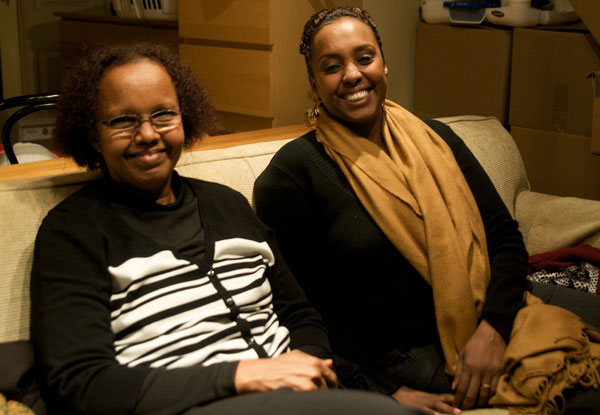 Fowsia Abdulkadir, Ikram Jama (Eyre, 2013)
Fowsia Abdulkadir, Ikram Jama (Eyre, 2013)
Let’s talk about what these songs have to say about how men and women should behave in this new, culturally authentic modern society.
O.K. I was reading at some point a conversation about what people thought the word ilbaxnimo meant in the context of the city of Mogadishu. Ilbaxnimo is kind of like "sophistication." It means not being a country hick. But there are lots of people who were saying that, for them, ilbaxnimo meant that you knew how to take a girl out, how to have a polite and sophisticated modern courtship. And so this is certainly part of this period of youth culture, during which young people tried to be respectful and Muslim, to observe what they considered it meant to be a good Muslim girl and young man, but at the same time wanted to be modern. So this is very actively debated in the pop songs.
Can we have some examples?
There's a song that is called "Guurkii runta ahaa waa lagu rafaado," "Truly Marriage Causes Hardships." It is a debate between different girls who are singing the song. And the first one says, "Truly marriage only causes hardship. It is impossible to build a family. To become an obedient wife means to be left behind by one’s age group. What I prefer is that when you and a man talk to each other, you go out in the early evening and dance to rock and jazz, hang out together, and enjoy yourselves, just the two of you. What do you think?" Now this, of course, is the bad girl. So in the song she represents an opinion that in the end will not be supported. That was the voice of Maryam Mursal, by the way.
And then Faadumo sings, "Everyone has his own preferences and taste is what sets people apart. One cannot tell who is wealthiest from the way people present themselves. What I prefer is rich men who turn over lots of wealth and have capital, who, while you live with them, put you in a huge house, and give you a luxurious life. What about you?"
And then the third singer, Hibo Nura, now in Rochester, MN: "Dear sister Ruun, don't get rid of the culture in which you were born or run away from your cultural heritage. Don't throw away the ways of your ancestors. What I prefer is a man who establishes a home with you, receiving you from your male relatives with their blessing. You will live together honestly, blessed by the Lord." So here is a debate. I argue that, over time, the prescriptions for being a good girl becomes stronger and stronger, while the one about how a boy should be a good boy, or how a man should be a good man, does not get much emphasis.
So the first girl presents this kind of amoral “modern” point of view.
Yes, there is no sexual modesty involved here. There's no limit on her physical movement in the public space and what she does sexually.
The second one is arguing more for looking for a rich man who's going to give her a comfortable life.
Even if he doesn't formally marry you. He puts you in a big house and takes care of you.
And the third one is arguing for a more moderate, even traditional, approach.
Well, the third one is here not actually arguing for a companionate marriage, right? She says, “What I prefer is a man who establishes a home with you, receiving you from your male relatives”—that's traditional—so she bows here in the song to the authority of the older male relatives. “With their blessing, you will live together honestly, blessed by the Lord.” So it is traditional. There are other songs that very much stress the fact that it's going to be a love marriage, and they're going to help each other as equal companions.
So listening to this song when it's being made in the '70s, do they come away thinking the third one is the one who's found the right balance?
Absolutely. Totally. That is what the songwriter intended. We have no audience research so we are not sure whether the audience really agreed. It did not become the most popular song!
The first two are corrupt, one way or the other.
Yes, because the power of the discourse of cultural authenticity is so strong. What I argue in the book is that, yes, obviously you want to build a nation. It's obvious that everyone wants a culturally authentic modernity, but we never talk about how a man could be a culturally, authentically modest and perhaps also modern woman. Which again is totally typical for nationalist eras in Middle Eastern and Muslim societies. So that’s not unique to Somalia. But it's worth pointing out that the burden of tradition is to be carried by the female body in terms of where she moves, in terms of her sexuality, in terms of how she behaves. And there's nothing wrong with that. I'm not saying it should be done differently. It's just that in the discourse, it is not emphasized as much that men can also go wrong and go against tradition. And in the songs, the issue of men’s cultural authenticity and morality is less visible. In the plays, sometimes you do see men who are getting into corruption and get caught and end up in prison. But men’s bodies are not under constant scrutiny. The popular culture of that time is rich and complex.
Here’s one song I particularly like, one in which the "modern" woman wins the argument.It’s a beautiful poem, and beautiful song text. It’s called "Beri hore waxa jiray." You could say "In the Old Days." And it is a debate between a man and a woman, sung by Mohamed Jaama Joof and Maryam Mursal also. He describes tradition beautifully. He says, "In the old days, it was custom that a girl perfumed her hair and braided it. She wrapped around her waist a wide cloth belt with fringes and in ornamented cord, and wore a white dress. But something has changed." (And the music, of course, will show that.) "Something weird with long horns"--now this is a strange ways of doing your headdress, your scarf--"something weird with long horns they wear on their heads and run all over the market." And then the refrain is, "You women have destroyed our culture. You have overstepped the religious law and destroyed our religion. Girls, would you behave?"
And then she comes in and says, "What was custom in the old days and 100 years ago, and what has been left behind, don't make us go back on that well-worn road, for we have turned away from it with great effort. Now we expect to run and compete for the sun and moon and to lead people." And her refrain is, "First get some education and learn how to read and write. Don't try to turn back, you country hick, people who have woken up."
She also has a verse that really talks about creation, and how God created the world. For a woman's voice to speak about that kind of a philosophical theme in public was remarkable. Then she comments on arranged marriage. So she says, "Girls used to be exchanged for a herd of camels and short-legged goats. But the religion we learned and the Koran do not allow this. Today we have no need for those who deal in what they do not own, and for this old-fashioned dividing up of women."
It's a song where in a sense, the modern woman's voice wins, while very often, as in the other one, the girl actually ends up accepting a little bit more of tradition, and she makes other "modern" women—often caricatures of the Somali girls of that time—look bad. Because how many loose girls really were there in Mogadishu in the 1970s? Obviously there were poor people and prostitutes, like in any other society. But the modern Somali girl was no looser than in other Muslim societies and very much in touch with her culture and religion.
But in this song, where the woman wins the debate, that’s unusual, but not unheard-of.
In a sense, what I think what you see in this song is that there is a real struggle, a tension in Somali popular culture about what is the right way of being culturally authentic and modern. So how can you be a modern girl and a modern guy? The man also wants courtship. They don't live in the countryside, where there were, by the way, very established forms of courtship. I don't think Somali culture was very prudish in any way. But now they're in a new society, in a new context, and they really believe in modernity, and so the debate of what that means is really very pertinent. And what is interesting is that in the songs, the girl's voice is the one that pushes for change. While we know that young men also wanted change. Young men, after all, were also constrained by older rules.
Now most of the texts in the pop songs of this period were created by men, but they were often created by men who were sitting with female artists. And my hypothesis has been that—while artists were spending time together, sometimes chewing qaat, sometimes not—that it was hard for a male poet to ignore the fact that they were surrounded by women in their society, wives, daughters, etc. So they do create a female voice that pushes for change, but they also create a female voice that tries to limit that change, with a particular focus on mobility and sexuality.
So that's what I think is happening. Many people did believe in education for women, and they did want to see marriage take the form of a love marriage. They wanted more equality between the sexes as an ideal. But in reality, these changes do not happen in the hearts of individuals. That kind of change comes with wider social change. And Maryan used to joke with me, and she said, "Ah, Somali men. In song, they are the most romantic possible. In reality, well, it's something else..."
That's wonderful. I'm interested in the way the songs create a kind of zone of equality that maybe doesn't exist in day-to-day life. You write in the book about the way in which in the songs both men and women suffer while in love; that they are, in the songs, "equals and companions." Expand on a little bit.
I think I argued that in the discussion of the song "Wisiisi." That song is one voice, and it's the woman's voice. This goes back to what we've are saying about putting very private feelings into the songs. One of the themes of the love song, apart from the debate about gender roles, is about love as an illness and affliction, as a wound, as pain, as a feeling that you don't control—that is certainly new in the public sphere and in Somali popular culture. And what is interesting is that, if you look at the songs, the man would say, "I can't sleep at night, and I grabbed the pillow thinking of you...." And I can quote you from Ahmed Ali Egal who sang in “Badtalaale,” one of his famous songs: "Do you know that I, in a miserable dream in the middle of the night, believed my pillow was you, and I put it on my chest, put it on my chest, put it on my chest, because of you. You know that when I wake up, I searched for you all around me on the bed, that I yearn for you, yearn for you, yearn for you." So it's a very, very romantic text. And it is a text about physical desire, which is certainly very modern. And the boy, the man, is as much afflicted as the woman is. And if anything, the woman's language might be a little bit less physical, but she will of course also be struck by love. So it's love as a wound, as well as all the dimensions of love: falling in love, falling out of love, being rejected, being accepted, coming to an agreement, finally entering marriage, or even divorce and being disappointed—it's all there in the love songs.
And so here is this song called "Wisiisi," which is "Longing," by Sahra Ahmed. It is a woman's voice. And it's a beautiful song. She sings, "Like a herd of untamed horses waits for the dawn, I am lamenting the furor of love. The blood which passes through my heart is not reaching the limbs of my body." And then the refrain comes: "I am still remembering the time now passed and the wonderful night gone by. I'm still calling for my companion, my companion with whom I used to share love." And then the second verse again goes to nature. “Like a cloud formation that is still holding its rain, I am heavy with memories, all alone. My ears do not listen to advice.…When they slaughtered a ram for his naming ceremony and said, ‘It is a boy,’ I was already destined for him. And love had already pierced me. I'm still remembering the time now passed, and the wonderful night gone by" and so forth. So she sings to him as an equal. And both the male voice and the female voice in the love songs sing about this very subjective strong desire that they feel.
What is interesting is that, in some of these songs, you also get a very realistic debate. "Yes, OK, you love me? What do you have? Are you hard at work to gather the bride wealth, because I'm not going to sit here and wait forever." And so you find different kinds of approaches to this, which I think is really interesting. In texts of this period, you will find commonly one of these themes: People are betrayed. People are disappointed. And couples, people cannot get each other because he cannot find the money to get married, or father is against it. There is a genre of older songs from the city Zeila, which was an Indian Ocean port city, in decline since the French founded Djibouti. And one of the famous stories is that a boy goes away with the ships to India, and he is delayed. And when he comes back, he has been delayed so long that he enters the port on the evening of his beloved’s wedding. She's just been married off. They both die, by the way, at the end of the song. So it's not that there was never talk of marriage and of love in the past, but this very, very strong personal feeling of desire expressed metaphorically, and even explicitly in song by both women and men, appears to be something new in the popular song.
There is a beautiful wedding song that Somalis when they first came to the U.S. after the collapse of the state still played at weddings. Now they have moved on. It's called "Xiisaha Kalgacalkeenna" (“The Yearnings of Our Love).” It's beautiful because when it asks for the blessings for a strong marriage, they bring up the elders, they bring up the religious men. The whole traditional apparatus is brought to bear on making this marriage work. And they say, “We have been blessed by all these traditional powers.” Then the second verse talks about the feelings they have for each other that make them bite their fingers. So now we talk about physical desire again. This is the way tradition is leveraged to give legitimacy to the modern.
Interesting. I’m sure it’s very nostalgic to hark back to this music, for those who remember the hope of the early independence years.
Yes, though not for everyone. Because after the civil war, some people said, "Well, it was never real. It didn't exist." This is a comment about the context of the songs. You know, when I first started working on the songs, I really didn't realize that this era had already come to an end in a sense. Because I think by 1985, it was dying. When Hargeisa and Burao were destroyed by their own government, in 1988, this is the moment, I think, that era of the hope for modernity and unity came crashing down. The nation-state died at more than one moment. But 1988 in the northwest and 1991 in Mogadishu are very important dates. And so what you hear now is that people say, "Well, those of you who lived these songs," like Ikram and Fowsia, whom you interviewed, "you were just hallucinating." This idea that you didn't know what clan you belong to, or if you knew, it had no meaning, that's just falseness. That's a falsehood." And I think that that's really totally untrue. I think that this national youth culture, this culture of hope for modernity that was built on Somali cultural authenticity was real for many Somalis.
However, I would say that what many Somalis, and maybe also people who studied Somalia, didn't realize is that the people who feel a connection to the songs, the people who felt that the songs were part of their youth, may not have been rich—but were socially mobile. They had parents who saw the importance of education. They often had families who were whole, where the father was not a low-level worker absent in the Gulf States. So I do think that, as the songs were flourishing, we had a countryside that was deeply underdeveloped, because the government was not really investing in the nomadic economy; and in the agrarian sector, there were more and more government cronies buying up land, creating and deepening inequality there.
In Mogadishu, meanwhile, we had the creation of slums, large slums, where people who were far less well-off may well have listened to the songs, but were not included in the dream of modernity. So I think we can look back and have no doubt that this was a culture that was widely shared; the hope for unity and modernity was really there. But already, population groups were falling out of this dream, or never became part of the dream. I think it is important for us to realize that. So when we talk about the pop songs, we have to see them as an ideal, an ideal that was real as an ideal, but not as a reality that actually came about.
There is one more song I would like to ask you about, "Ilwaad Quruh."
Maryam Mursal
The song "Ilwaad Quruh" means "You Beautiful One." It is a love song that is very emotional and has a beautiful melody. It is sung by a man and woman, and they sing back and forth. He says, "If you were not so close to my heart, I would not be longing for you every day..." and then he adds a number of things that would not happen if he did not love her so much. "If you were not so close to my heart, I would not be praising you every day. You beautiful one with your beautiful character. The only way that my heart would be at peace is when I can marry you, and you would become my wife. You beautiful one, you are so beautiful look at.” And then she actually responds in a similar vein: "If you were not so close to my heart, my eyes would not be crying all the time, and the only way my heart would find peace is if you became my husband and I became your wife." They keep singing back and forth, listing the symptoms, or the evidence, of how much they love each other. They are totally equal, equally in love, and singing about their feelings to each other in very similar ways.
And tell us about the female singer on this song.
Yes, this is Magool [mah-GOHL]. Halima Khalif is her name; Magool, “Blossom,” is her artist's name. I would say that she is undoubtedly one of the greatest singers of Somalia. It's hard. I told you beforehand that we would not start mentioning names, because people have their favorites. Sometimes their favorites are people they are related to. But there are so many. It's like apples and oranges; they all have something beautiful. But I would say that Magool—who is also a relative of K'Naan—is one of the greatest singers of Somalia. She is no longer alive. She has different stages of using her voice. There is one stage where she modulates her voice more. For me, personally, I like the earlier Magool and also the later Magool a little bit better. She has absolutely wonderful songs. She can sing any kind of song. The range of her voice, the quality of the songs composed and created for her are really wonderful. She's a major part of this whole culture of culturally authentic modernity.
You know, her song "Sidii Hogosha Roobka” is the one that K'Naan uses in "Fire in Freetown." The refrain of the original song is, "Like lightning in a downpour of rain, only 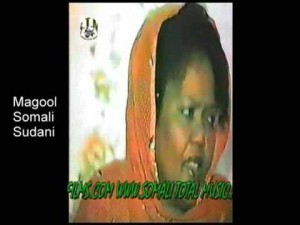
you light up in front of me." And you know, K’Naan beautifully works in some of the traditional Somali music. So this qaraami song that is sung by Magool, his aunt, becomes the refrain in "Fire in Freetown." Now, "Fire in Freetown"—I don't know what you think it's about. Is it about desire? Is it about drugs? It's about something very powerful. “Only you are visible to me. Only you light up before me.” And so what he uses to express this is this qaraami song by Magool.
Maybe you could just comment generally about K'Naan and his work, particularly how he's used these traditions. Of course, he is free to do whatever he wants. He's a hip-hop artist. But he chooses to draw on these traditions. What do you make of that?
Well, musically, his explicit direct use appears to be limited, but is it not astounding that he “cites” directly, as in the case of "Sidii Hogosha Roobka"? I mean, you can just go and look that Somali song up on the web. It is courageous and creative to do that for an audience that knows very little about Somalia and may care less. Another one he uses in his song "Until the lion learns to speak." Actually, there is a Somali singer who has now passed away, Allah ha u naxariisto [May God rest his soul] called 'Areis 'Isa [Arais Essa], who actually sang rap. This is a different genre from the pop song as a whole. And actually K'Naan takes the melody of that song and acknowledges 'Areis ‘Isa. The original song is on the web, on YouTube. The song is a conversation between animals, a sheep and a hyena. But I think that K'Naan did something beautiful with it. "Until the lion learns to speak, the tales of hunting will be weak." And it is absolutely the melody and the rhythm of that song, and any Somali would recognize this as the melody and the style of 'Areis ‘Isa. And I think it's a great tribute that he pays to this singer.
And in the same way, his texts, of course, are drawn from Mogadishu, and everyone can hear that. Of course, the most famous song was "Soobax," where he tells the warlords to, for heavens sake, get out of the country. “You have spilled our blood. You have burnt our land. Get out from among us.” So he actually says that in Somali. And it is a song about being dominated by warlords. I think that that takes guts, and he made it work.
K'Naan
And he has other references to Mogadishu, but the one that I really like, because it is relevant to the period of the pop song, the good days in Mogadishu, is the song “My Old Home,” which I quote in my essay “Making Memories of Mogadishu.” He says, "The rain drops cool, neighbors and dwellers spatter in the pool, kids playing football with sand in a sock. We had what we got, but it wasn't a lot. No one knew they were poor. We were all innocent to grief’s judgment." And then this is the part I really like. "The country was combusting with life like a long-hibernating volcano." This was just after independence. "With a long tail of success like J. Lo. Farmers, fishers, fighters, even fools had a place in production. The coastal line was a place of seduction. And women walked with grace and perfection." And he goes on. And this is the time, these were the people who had hope for the future, who wanted to be modern. It is this hope after independence that we find in the pop songs, and I think he captures it beautifully.
B.E.: We’ll come back to K’Naan and the song “Fatima,” but first, let's talk about one of the most famous plays of the early independence era, Shabeelnaagood by Hassan Sheikh Mumin.
L.K.: It was translated by the same person, Andrzejewski, who was the Cushitic reader and Somali teacher at the School of Oriental and African Studies in London, with whom John Johnson worked as a Ph.D. student. Andrzejewski was really a powerful intellectual, and he translated something from practically every genre. And one of the theater plays that he translated was Shabeelnaagood, which he translated as "Leopard Among the Women." I think this is from 1967, just before the military coup of '69.
Shabeel means ‘leopard,’ and naagood means ‘of women.’ So this is a person who hunts down innocent girls and makes them pregnant. He seduces these girls with the promise of marriage. He even goes through a fake marriage with them, with a fake holy man, and all this is to be kept secret because he's modern and he's exciting, and he makes the girls feel old-fashioned and dumb if they do not join him in his modern ways.
So there are the gender relations of the play. But let me first say something about the politics of the play. There are some beautiful poems in the play that deal with the political situation, and one in particular talks about the political frustration of the period just before the military coup. And the poet, Hassan Sheikh Mumin, asks, "If the fire gets cold, who will warm the fire? What happens if the fire gets cold?" With the “fire” that got “cold,” he means men elected to high office who failed to fulfill the trust placed in them. He also asks, “If the medicine gets ill, who can cure the medicine?" explaining that when “the straight path of faith, the constitution and the laws are dimmed and covered up, it is they who are the medicine which feels ill.” He gives a number of examples of what is politically wrong, and then the answer is that only the people can bring a solution. And this is just before the military coup that introduces (and subsequently distorts and makes a travesty of) “scientific socialism.” So truly the artists of this period, they had their finger on the pulse of society—nobody can deny that—politically, emotionally, socially, in many different ways.
Now, on the level of gender relations, Shabeel seduces this innocent girl who gets pregnant, and then he says, "What do you mean? This is all a joke. I've nothing to do with you. I don't know you." And then it is Maryam Mursal, I think, who sings about how she feels when she can't tell her parents—she will have to at some point. She is pregnant in the society that is very disapproving of something like this. So, not having told her parents yet, and feeling totally betrayed, she uses this beautiful metaphor: "Like a mountain oryx with an arrow in his body, lamenting and calling, yesterday at dead of night. Again and again I stumbled down the steep banks–but sought you all in vain.” This is cited from Andrzejewki’s translation, and then her refrain is, "You know what has burned me, so acknowledge what you did to me, for you did me a great wrong." It's a beautiful, very powerful song, and she sings it with incredible emotion.
I’ve heard it. It is fantastic.
Now, the other characters in this play are two teachers. These teachers represent a kind of respectable modernity. And one of the funny things in the play is that they really want each other. They have no idea how to express that because she is full of feminist furor. He wants to do the right thing, but he has no idea how to court a woman like that. So eventually, she finds an orphan boy, and then the orphan boy, whom they will actually raise, becomes kind of an excuse for them to get married and to find each other, which I think the poet did in a really nice way.
But the conversation and the singing between the two teachers perhaps constitutes the iconic feminist text of this period. Most Somalis over age 40 would be able to quote and recognize this. This is Andrzejewski's translation; I have translated it slightly differently myself. She (Hibo Nuura playing the female teacher called Diidan) sings, "Women have no share in the encampments of this world, and it is men who have made these laws, to their own advantage. By God, by God, men are our enemies. Though we ourselves nurtured them. We suckled them at our breast, and they maimed us. We do not share peace with them." And then she says [Sings] "Allah, Allah nimanku waa nacab aan korinnoo ..." "men are the enemy we raised ourselves … We are not sharing peace of them. We can't."
And then he, the male teacher called Diidan, played by the gifted artist Abdi Muhumed, comes back, and he actually speaks beautifully. He says, "Men and women are two creatures who grew from the same first fiber, the same blood. And they share this life. Listen, listen, women, men are the green grass, the comfort, the very sustenance of women. Men and women are a she-camel and her baby, who take their radiance from each other." And then he uses the Islamic term for sustenance (nafaqada), which is what husbands should provide to their wives. So these are very powerful terms in Somali. But if you say to Somali women, "Allah, Allah nimanku..." they will say, "Ah, it's like that. We raised them but they are still men!" So this is a very famous song, but I think his response is also beautiful: “Men are like the green grass, the comfort, the very sustenance of women.”
That's great. And doesn't Mohamed Afrah write that the whole play can be taken on a political level as well? The idea is that the whole country has been despoiled, like these young girls.
Yes. So Mohamed Afrah has written a dissertation at SOAS that hasn't been published yet. But he did publish an article called "Abwaan as Beacon" where he pulls out the indirect political messages of the play. Not so indirect as the one that I quoted already “if the medicine is ill, who will cure the medicine?” But I think he argues that when the girl is made pregnant, and then abandoned, that this could also be a metaphor for the whole of Somalia, and that the civilian administrations did not treat it well enough. And this is very common—a tradition that I've been talking about from the '50s onward, in the anticolonial songs, that the Somalis would act as if it was about something else, but it was really a very, very clear political message.
I don't know whether you've heard of a BBC Somali journalist called Elizabeth Blunt. She's retired but is still working and living in Ethiopia. And when I met her in Jigjiga, she told me, "Oh my God, we were having such problems at the BBC Somali service during the Barre regime (1969-91). Because we would get this complaint from the military government, 'Why are you airing antigovernment propaganda?' And we said, ‘What did we do?’ 'Well, look at this poem. “This camel is not being taken care of properly. And the camel herders are not feeding it well enough.”' And we would get this whole explanation about why this was antigovernment propaganda. Well, for us, it was just a song about a camel herder who did not take care of his camel." By the way, do not take this story too literally; I'm sure this was kind of a standing joke. But it tells you something about these very powerful metaphors.
There were also song references to the widow, the woman with the white mourning cloth, a white scarf tied around her head as sign of mourning, as I mentioned before when speaking about Johnson’s book. The song is a lament about a woman wearing a white head cloth, but the song is, in fact, about Somalia being bereaved because of colonial mistreatment and in mourning. We could do a whole Afropop program about the political songs, the songs lamenting the missing territories and all that. That's not where we're going to go now, but the thematic range of the songs lamenting the missing territories and all that. That's not where we're going to go there now, but the thematic range of the songs is really quite extensive.
That's wonderful. Before we end, why don’t you tell us about a couple of the war songs?
All right. When I started the project for my last book, which became a book about the war, the civil war, my initial intent was to look at popular culture about civil war violence. And there definitely are songs, and very powerful songs. But I discovered that the popular song was not an authoritative space to talk about war, while I think the pop songs are a very authoritative space, and iconic for this period of hopeful modernity in the nationalist era. And so, instead of popular songs about the war, I turned to the poetry that could be recited at the international reconciliation meetings, and that's where my book took a different direction.
What happens with the civil war is that the national ideal, the ideal that every Somali is a brother and sister to another Somali gets distorted. For example, among Somali students in the U.S. in the '70s and '80s, if a young Somali couple got married in California, people would travel in groups from Washington, DC and other cities, in spite of the fact that they had hardly any money to go there and support this couple. That's how they respected Somali-ness. There was really a feeling of national commonality. I don't think that's totally gone, but it has been really, really damaged by the violence that has happened in the civil war.
Nevertheless, the artists have always been the voice of all Somalis, the national voice. They are the ones who helped create this whole national culture, and that's also why they were so respected, even though the position of artists in Somalia, like in many Muslim countries, was not high. They were not always well paid, etc.
There are some songs we can note from the war period. One is “Khad Cagaaran” by Abdulkadir Juba. It is from the album Qiso, which means “Story.” The first line talks about "the clan wars,” and it is kind of a lament. But it's also really creative and funny. Because after addressing the ways in which different clan groups were set up against each other, something that really has caused harm, he sings, "But, if you really are in love, that's not going to stop you. You will not despair." And then sings, "You, United Nations, who take care of refugees. Is sending love letters across the Green Line [which is the Green Line dividing Mogadishu in the early and mid-1990s] part of your work? It is a part of your work to pass letters across the Green Line because that would really satisfy my heart, and I would calm down a little bit."
Abdulkadir Juba has a beautiful, beautiful voice, and it's a lovely song. And at the same time, you hear how he laments the fact that the civil war happened. The second verse begins with him explaining how different groups were packed off in different directions. And then he says, "I am actually singing for those who didn't make it. I'm singing for those who were killed." At the same time, it's a really upbeat, lovely song. Very creative. I think it was possible by the time he sang that to sing with a little bit of humor.
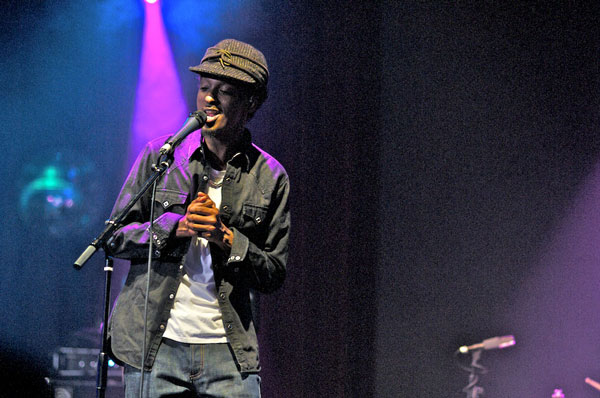 K'Naan, Highline Ballroom (Eyre 2012)
K'Naan, Highline Ballroom (Eyre 2012)
And when did he sing it?
It's a good question. I think late-'90s but it could be somewhat later. It is certainly after the state had collapsed, as he produced it outside of Somalia and thus without a real orchestra. And then, of course, we have K'Naan with his lovely song called "Fatima." I saw an interview clip on YouTube, and I think you also interviewed him about this song. I don't know if most people understand that he is talking about the fact that this girl was killed by gunmen. Because it is mostly an absolutely lovely love song. But when he was asked about it, he said, “Well I wanted to write a love song because I wanted to remember her." He said she was a girl living next door. He says she spoke Swahili and Arabic, so what he is invoking—for someone who knows Mogadishu—is that she was a girl who belongs to what we call the original Banadiri population of Mogadishu, a kind of a Creole population that has its own language, or perhaps I should say dialect. They are the oldest inhabitants of Mogadishu who are an intermixture of people who came from the outside and local people.
So are they sort of cosmopolitan? People who have a wider sense of culture?
Yes. I think all Somalis are, or used to be, compared to Americans. Somalis will beat them in knowledge of the world; they will know geography more than the average American. It was certainly an Indian Ocean coastal society. But we're going back now to when Mogadishu was a Sultanate in the 11th century. So we’re going way back. But they're the ones who lived traditionally in the old tall coral reef houses of Mogadishu’s old town. So already you get an idea of... It's interesting, actually, because those girls observed purdah, or seclusion, more than girls of other Somalis subcultures, in Mogadishu or elsewhere. So that he gets to climb the ladder with her and have private chats with her is already really interesting.
But it is true. He actually does say that the gunman came and took her away, and yet he wants to remember her as the beautiful girl he was forced to leave behind. And it's also very creative text. “You would have loved the parks in Connecticut; you would have said I am working too hard again.” He makes all kinds of emotionally powerful and linguistically brilliant connections. And he brings her to life, in a sense, from the U.S.
And so that is a reference to the war. But in general, we don't have very many songs that explicitly deal with it. There are laments. There's another one that I particularly like by Mohamed Hasan Husein Lafole, where he says, "If you're going to feel superior to each other all the time, and just cling to clanism, then those of you who will survive will only be ruling the graves." That's a pretty powerful song also.
Interesting. I guess the situation is so much more dispersed now, it's hard to have the kind of universal impact of the pop songs we've been talking about.
Yes. How do you address any of the specifics of the civil war if you are singing for all Somalis, for the civil war violence has divided Somalis deeply. So I think it's really a difficult position that the singers are in. And you know, it is really saddening. Ahmed Samatar, whom you will interview, brought some of the really fantastic singers to his college, Macalester College. One of them was Faadumo Qaasim. She sings in the Benadiri tradition, the tradition of the original people of Mogadishu. Very different, more influenced by Arabic music. And I hope you can play a small excerpt of one of her songs, because it's just a really different and beautiful genre. She died just a few years ago.
When she came on stage at Macalester College, it was just total rhythm. What a musical presence. She was a big woman by then. She just came on stage and everything was swinging just because of her presence. The whole audience was singing along with her! We talked to the artists afterwards, and they said, "We are laughing and crying because when we were in Somalia, we performed in places such as the National Theater. We performed in respectable places. Now, sometimes you get invited to weddings. People mean well. But we're just in a crowd of dancing people. People mean well, they bring us, but there is no respect for our art. We are just party entertainers." So when Ahmed put them on stage at Macalester, this really reminded them of who they once were. They were really once central to the national cultural scene. And their voice was important. It was. It reflected, of course, the realities of the day, but it also shaped them. They were very committed to overcoming clan differences, overcoming differences of caste, overcoming these inequalities. But they were not stronger than the development of the postcolonial state, postwar mechanisms, and those other real-life forces that can undermine people's unity.
What an amazing experience. I will ask him about that. Finally, I'd like you just tell me a little bit about the one Somali artist, other than K'Naan, who has had a major international release. And that's Maryam Mursal, who had this wonderful 1998 release on RealWorld called The Journey.
Most Somali popular singers who feature in Women's Voices, if they are still alive, have continued to produce (except for a few who turned to religion and have given up singing). They put out first cassettes, and then CDs, in Canada, U.K. and in many different places. But they have not crossed over like Maryam Mursal. Maryam Mursal ended up in Sweden, and I do not know exactly how this project started, but she has this amazing CD called The Journey. The CD is a combination of old and new songs. Most of the songs are old, but the song called "Qax" (Flight, Exodus into Exile), which they translate as "Refugee" here, is new. She also has one called "Somali u diida ceeb" [Somalis avoid bringing shame on yourselves]. It is a very nationalist song where she says things like, "We have a beautiful country. Everything is there. We have the rivers. We have this, we have that, and we should try to respect the reputation we used to enjoy in our country."
But the one that I really, really love is "Qax," and in it, she actually tells the story of her flight. And she begins with Mogadishu, and I think she says, “My eyes saw blood. There was firing.” And she talks about the mayhem of war that made her leave Mogadishu. Then she describes her journey place by place. She goes first to the Kenyan border and then eventually ends up in Ethiopia. And on the way, she says things about the Kenyans. “We knew that there was kind of African solidarity with them.” And then when she comes to Ethiopia also, she says about the Somali-inhabited area of Ogedania or Western Somalia: "that we were of the same blood, that we were kin, became clear to me at that time," because she received help and support there.
Then she gets to Djibouti, and the government of Djibouti gets a little bit of a kick from her, because, by then, Djibouti and had so many ordinary and well-known refugees that the government was a bit burned out. So when Maryam Mursal arrived, she sings: “Our caravan ended up in 'Kartoon' the 'Cardboard Village!'” It is actually a kind of shanty, quite rough, quite far from the city of Djibouti. Maryan knew that story, and she said it was not quite fair to the Djibouti government, because they did so much for Somali refugees. But Maryam Mursal was not pleased. And then she describes how she went on the plane to Sweden, and how well treated she was, and how cold it was, etc.
But in textual terms and musically, I think it is fantastic. And I believe that she authored that song text. There are very few female singers artists who created song texts that entered the public domain before 1991, an exception being singer and now member of parliament in Somalia, Sado Ali. This is largely a new phenomenon that has emerged in the diaspora.
This has been such an education. So rich! Thank you very much for all this.
My pleasure.








